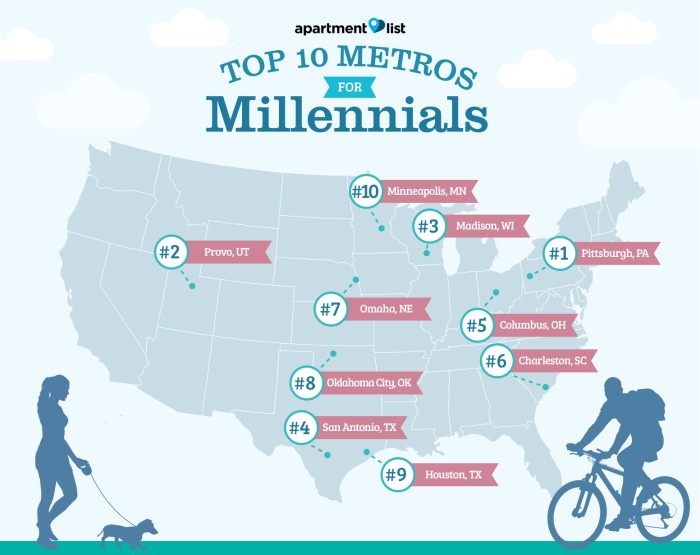Utah Has a Top Ranked U.S. Metro City for Millennials
This article written by Sydney Bennet, of “Apartment List” is great news for the Utah Economy and housing market:


The best three metros for millennials are Pittsburgh, Provo, Utah, and Madison, Wis., which all earn A+ marks overall.
Largely, inland metros, primarily located in the Midwest and South, rank higher than coastal metros, offering affordable options for millennials, in addition to strong job markets and plentiful entertainment options. Metros where millennials traditionally move — San Francisco, Los Angeles and New York — and where millennials have recently been moving — Seattle, Austin, Tex., and Denver — receive low scores for affordability. Despite strong job markets and high livability ratings, rents in these metros are too expensive for many millennials, and homeownership is far out of reach for most.Introduction
Making a move to a new city is both scary and exciting. A big move can mean leaving friends and family behind, starting a new career or experiencing an entirely new climate. In our recent survey of 24,000 renters, 64 percent of renters say they plan to settle down in a different city than where they currently live. Affordability concerns drive renters away from pricey coastal metros, while renters leave the Midwest and South in search of better job opportunities. Millennials, aged 18 to 34, have higher rates of migration, compared to older adults, frequently relocating for better jobs, cheaper housing or a more exciting social scene. From 2007 to 2012, millennials made up 24 percent of the total U.S. population, but accounted for 43 percent of all movers in the United States. In order to identify the best metros for millennials, Apartment List created an index to grade 75 top U.S. metros on jobs, affordability and livability. We calculate the score within each category based on how the metro compared to the others in the study, with overall grades and rankings determined by the average score of the three categories. The metros that top our list provide millennials a balance between a strong job market and reasonable rent and home prices, as well as a lively social scene.Methodology
Apartment List based our index on three equally-weighted categories important to millennials:-
- Jobs: The strength of a metro’s job market is based on median wages1, wage growth2 and the millennial unemployment rate3
- Affordability: Affordability is calculated using Apartment List median rents4and the share of households that can afford the median-priced home in their metro5
- Livability: To measure livability, we use data from our annual survey of 24,000 renters. We look at how satisfied renters are with the following factors in their metro:
- Weather
- Access to parks, community activities and nightlife
- Opportunities to date and make friends
- Safety and low crime rates
Read More
SEARCH ALL UTAH Homes
Linda Secrist’s Salt Lake City Real Estate Home Page • Salt Lake City Real Estate • Draper Utah Real Estate • Holladay Utah Real Estate • Sandy Utah Real Estate • South Jordan Utah Real Estate • Salt Lake City’s Top Real Estate Agent
 Linda Secrist & Associates are the top selling team in luxury homes in the SLC Market. They have received countless awards over the past 20 years, including “Sales Team of The Year” for over 10 years! Linda Secrist is in the top 100 Agents in the World in luxury residential real estate. If you’re searching for homes in Sandy, Salt Lake, Cottonwood Heights, Millcreek, Draper, South Jordan, Bountiful, Centerville, Farmington or anywhere in northern Utah, Linda Secrist & Associates are the real estate agents to call. If you’re buying or selling a home, don’t hesitate to text or call us at 801-455-9999!
Linda Secrist & Associates are the top selling team in luxury homes in the SLC Market. They have received countless awards over the past 20 years, including “Sales Team of The Year” for over 10 years! Linda Secrist is in the top 100 Agents in the World in luxury residential real estate. If you’re searching for homes in Sandy, Salt Lake, Cottonwood Heights, Millcreek, Draper, South Jordan, Bountiful, Centerville, Farmington or anywhere in northern Utah, Linda Secrist & Associates are the real estate agents to call. If you’re buying or selling a home, don’t hesitate to text or call us at 801-455-9999!
#mcm #wcw #utahhomesforsale #openhouse #homebuying #utahluxuryhomes #buyahome #homebuyer #utahrealestate #utahrealtor #no1realestateagent #homesforsaleinutah #bestrealtor #skiutah #utahlistings #mlslistings #skiutah #funthingstodoinutah #relocatetoutah #thegreatestsnowonearth #utahskiresorts #worldclassskiresorts #utaheconomy #utahinvestments #stagingyourhome #villasatdimpledell #searchutahhomes #luxuryhomesforsaleinutah #mainfloormaster #homesforsaleinsandyUT #homesforsaleinpepperwood #sharethewarmth #searchutahhomes

